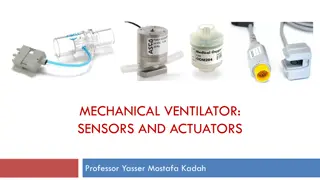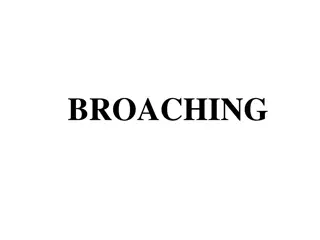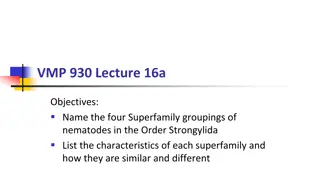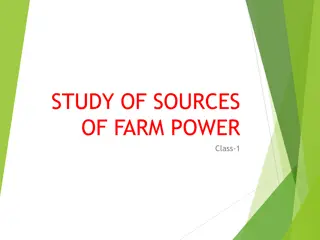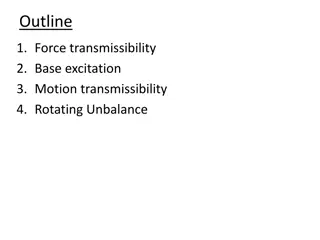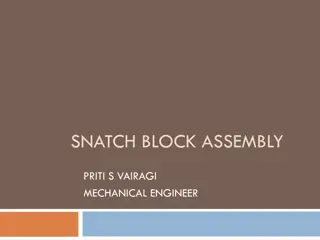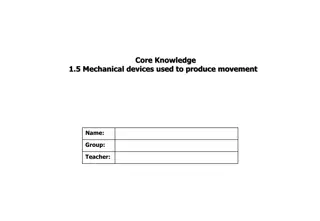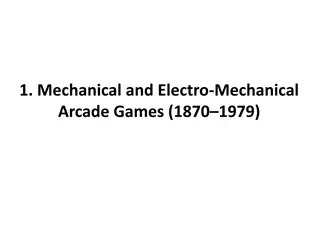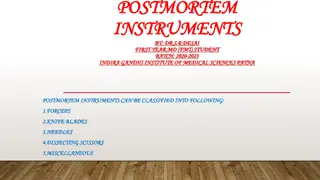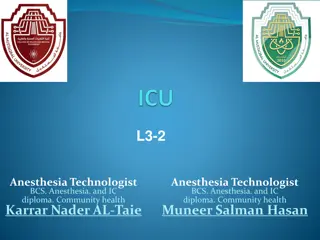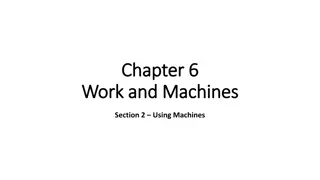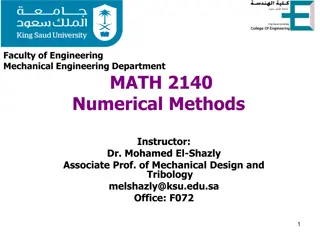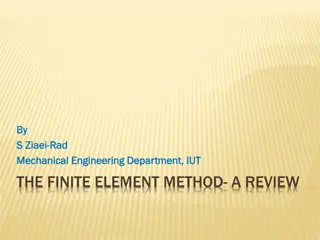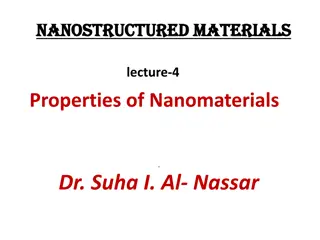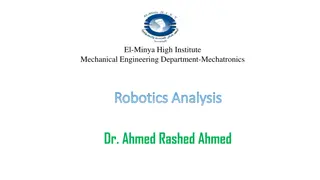Understanding Toothed Gearing in Mechanical Systems
Toothed gearing plays a crucial role in transmitting motion and power efficiently between two shafts. This chapter covers the advantages, disadvantages, and classification of toothed wheels including spur gears, helical gears, bevel gears, and more. It explains how toothed wheels help avoid slipping in the transmission system, ensuring precise velocity ratios and reliable service in machinery. Different types of gear arrangements and their applications are discussed in detail.
Download Presentation

Please find below an Image/Link to download the presentation.
The content on the website is provided AS IS for your information and personal use only. It may not be sold, licensed, or shared on other websites without obtaining consent from the author. Download presentation by click this link. If you encounter any issues during the download, it is possible that the publisher has removed the file from their server.
E N D
Presentation Transcript
FIRST SEMESTER CHAPTER FIVE Toothed Gearing Dr. Adil ABed Nayeeif 2019-2020 1
Introduction 2 We have discussed in the previous chapter, that the slipping of a belt or rope is a common phenomenon, in the transmission of motion or power between two shafts. The effect of slipping is to reduce the velocity ratio of the system. In precision machines, in which a definite velocity ratio is of importance (as in watch mechanism), the only positive drive is by means of gears or toothed wheels. A gear drive is also provided, when the distance between the driver and the follower is very small. Friction Wheels Consider two plain circular wheels A and B mounted on shafts, having sufficient rough surfaces and pressing against each other as shown in Figure(1). Let the wheel A be keyed to the rotating shaft and the wheel B to the shaft, to be rotated. A little consideration will show, that when the wheel A is rotated by a rotating shaft, it will rotate the wheel B in the opposite direction as shown in Figure(1). Figure(1)
In order to avoid the slipping, a number of projections (called teeth) as shown in Figure(2), are provided on the periphery of the wheel A, which will fit into the corresponding recesses on the periphery of the wheel B. A friction wheel with the teeth cut on it is known as toothed wheel or gear. The usual connection to show the toothed wheels is by their pitch circles . 3 Advantages and Disadvantages of Gear Drive Advantages 1. It transmits exact velocity ratio. 2. It may be used to transmit large power. 3. It has high efficiency. 4. It has reliable service. Figure(2) 5. It has compact layout. Disadvantages 1. The manufacture of gears require special tools and equipment. 2. The error in cutting teeth may cause vibrations and noise during operation.
Classification of Toothed Wheels 4 1. According to the position of axes of the shafts (a) Parallel, (b) Intersecting, and (c) Non-intersecting and non-parallel. The two parallel and co-planar shafts connected by the gears is shown in Figure(2). These gears are called spur gears and the arrangement is known as spur gearing. These gears have teeth parallel to the axis of the wheel as shown in Figure(2). Another name given to the spur gearing is helical gearing, in which the teeth are inclined to the axis. The single and double helical gears connecting parallel shafts are shown in Figure (3) (a) and (b) respectively. The double helical gears are known as herringbone gears. A pair of spur gears are kinematically equivalent to a pair of cylindrical discs, keyed to parallel shafts and having a line contact. The two non-parallel or intersecting, but coplanar shafts connected by gears is shown in Figure(3) (c). These gears are called bevel gears and the arrangement is known as bevel gearing. The bevel gears, like spur gears, may also have their teeth inclined to the face of the bevel, in which case they are known as helical bevel gears. Figure(3)
2. According to the peripheral velocity of the gears. (a) Low velocity, (b) Medium velocity, and (c) High velocity. 5 The gears having velocity less than 3 m/s are termed as low velocity gears and gears having velocity between 3 and 15m/s are known as medium velocity gears. If the velocity of gears is more than 15 m/s, then these are called high speed gears. 3. According to the type of gearing. (a) External gearing, (b) Internal gearing, and (c) Rack and pinion. In external gearing, the gears of the two shafts mesh externally with each other as shown in Figure(4) (a). The larger of these two wheels is called spur wheel and the smaller wheel is called pinion. an external gearing, the motion of the two wheels is always unlike, as shown in Figure (4) (a). In internal gearing, the gears of the two shafts mesh internally with each other as shown in Figure (4) (b). The larger of these two wheels is called annular wheel and the smaller wheel is called pinion. In an internal gearing, the motion of the two wheels is always like, as shown in Figure (4) (b). Sometimes, the gear of a shaft meshes externally and internally with the gears in a straight line, as shown in Figure (5). Such type of gear is called rack and pinion. The straight line gear is called rack and the circular wheel is called pinion. Figure (4) Figure (5)
Terms Used in Gears 6 The following terms, which will be mostly used in this chapter, should be clearly understood at this stage. These terms are illustrated in Figure (6). Figure (6)
1. Pitch circle. It is an imaginary circle which by pure rolling action, would give the same motion as the actual gear. 2. Pitch circle diameter. It is the diameter of the pitch circle. The size of the gear is usually specified by the pitch circle diameter. It is also known as pitch diameter. 7 3. Pitch point. It is a common point of contact between two pitch circles. 4. Pitch surface. It is the surface of the rolling discs which the meshing gears have replaced at the pitch circle. 5. Pressure angle or angle of obliquity. It is the angle between the common normal to two gear teeth at the point of contact and the common tangent at the pitch point. It is usually denoted by . The standard pressure angles are 14.5 and 20 . 6. Addendum. It is the radial distance of a tooth from the pitch circle to the top of the tooth. 7. Dedendum. It is the radial distance of a tooth from the pitch circle to the bottom of the tooth. 8. Addendum circle. It is the circle drawn through the top of the teeth and is concentric with the pitch circle. 9. Dedendum circle. It is the circle drawn through the bottom of the teeth. It is also called root circle. 10. Circular pitch. It is the distance measured on the circumference of the pitch circle from a point of one tooth to the corresponding point on the next tooth. It is usually denoted by D pC = C p . Mathematically, Circular pitch, T Where D = Diameter of the pitch circle, and T = Number of teeth on the wheel. A little consideration will show that the two gears will mesh together correctly, if the two wheels have the same circular pitch.
11. Diametral pitch. It is the ratio of number of teeth to the pitch circle diameter in millimeters. It is denoted by . Mathematically, T p = = 8 Diametral pitch, D P d C 12. Module. It is the ratio of the pitch circle diameter in millimeters to the number of teeth It is usually denoted by m. Mathematically, Module, m = D /T. 13. Clearance. It is the radial distance from the top of the tooth to the bottom of the tooth, in a meshing gear. A circle passing through the top of the meshing gear is known as clearance circle. 14. Total depth. It is the radial distance between the addendum and the dedendum circles of a gear. It is equal to the sum of the addendum and dedendum. 15. Working depth. It is the radial distance from the addendum circle to the clearance circle It is equal to the sum of the addendum of the two meshing gears. 16. Tooth thickness. It is the width of the tooth measured along the pitch circle. 17. Face width. It is the width of the gear tooth measured parallel to its axis. 18. Length of the path of contact. It is the length of the common normal cut-off by the addendum circles of the wheel and pinion. 19. Arc of contact. It is the path traced by a point on the pitch circle from the beginning to the end of engagement of a given pair of teeth. The arc of contact consists of two parts, (a)Arc of approach. It is the portion of the path of contact from the beginning of the engagement to the pitch point. (b)Arc of recess. It is the portion of the path of contact from the pitch point to the end of the engagement of a pair of teeth.
Condition for Constant Velocity Ratio of Toothed WheelsLaw of Gearing 9 Consider the portions of the two teeth, one on the wheel 1 (or pinion) and the other on the wheel 2, as shown by thick line curves in Figure (7). Let the two teeth come in contact at point Q, and the wheels rotate in t he directions as shown in the figure. Let TT be the common tangent and MN be the common normal to the curves at the point of contact Q. From the centres O1and O2, draw O1M and O2N perpendicular to MN. A little consideration will show that the point Q moves in the direction QC, when considered as a point on wheel 1, and in the direction QD when considered as a point on wheel 2. Let v1 and v2 be the velocities of the point Q on the wheels 1 and 2 respectively. If the teeth are to remain in contact, then the components of these velocities along the common normal MN must be equal. v1 cos = v2 cos ) ( ) cos cos Q O Q O 2 2 1 1 = N O 2 O M O N ( ) ( ) ( = O Q 1 O Q 1 2 O Q 1 O Q 1 2 2 2 1= = O M O N O M 1 1 2 2 2 1 O N O P O P = = 1 2 2 1= Also from similar triangles O1MP and O2 NP, If D1 and D2 are pitch circle diameters of wheels 1 and 2 having teeth T1 and T2 respectively, T D P O 2 O M O P O P 2 1 1 2 1 O P D = = = 1 2 2 2 Figure (7) T 2 1 1 1
Length of Path of Contact 10 Consider a pinion driving the wheel as shown in Figure (8). When the pinion rotates in clockwise direction, the contact between a pair of involute teeth begins at K(on the flank near the base circle of pinion or the outer end of the tooth face on the wheel) and ends at L(outer end of the tooth face on the pinion or on the flank near the base circle of wheel). MNis the common normal at the point of contacts and the common tangent to the base circles. The point Kis the intersection of the addendum circle of wheel and the common tangent. The point Lis the intersection of the addendum circle of pinion and common tangent. The length of path of contact is the length of common normal cutoff by the addendum circles of the wheel and the pinion. Thus the length of path of contact is KL which is the sum of the parts of the path of contacts KP and PL. The part of the path of contact KP is known as path of approach and the part of the path of contact PL is known as path of recess. Figure (8)
rA= O1 L= Radius of addendum circle of pinion, RA= O2K = Radius of addendum circle of wheel, r = O1P = Radius of pitch circle of pinion, and 11 R = O2P = Radius of pitch circle of wheel, From Figure (8), we find that radius of the base circle of pinion, O1M = O1P cos = r cos and radius of the base circle of wheel, O2N = O2P cos = R cos KN = ( ) ( ) ( ) = 2 2 2 O K O N R R cos Now from right angled triangle O2 KN, PN = O2P sin = R sin 2 2 A 2 2 ( ) = = 2 KP KN ( ) r A PN R R R cos sin Length of the part of the path of contact, or the path of approach, 2 2 A ( ) ( ) Similarly from right angled triangle O1ML, MP = O1P sin = r sin = = 2 2 2 ML O L O M r cos 2 2 1 1 ( ) r A Length of the part of the path of contact, or path of recess, = = 2 PL ML MP r r cos sin 2 2 Length of the path of contact ( ) ( ) r A ( ) = = + + 2 2 KL KP PL R R r R r cos cos sin 2 2 2 2 A
Length of Arc of Contact 12 We have already defined that the arc of contact is the path traced by a point on the pitch circle from the beginning to the end of engagement of a given pair of teeth. In Figure(8), the arc of contact is EPF or GPH. Considering the arc of contact GPH, it is divided into two parts i.e. arc GPand arc PH. The arc GPis known as arc of approach and the arc PHis called arc of recess. The angles subtended by these arcs at O1 are called angle of approach and angle of recess respectively. Length of Path of approach KP = = We know that the length of the arc of approach (arc GP), cos cos Length of Path of recess PL = = and the length of the arc of recess (arc PH), cos cos Since the length of the arc of contact GPH is equal to the sum of the length of arc of approach and arc of recess, therefore, KP PH arc GP arc + = + = PL Length of the arc of contact cos cos The contact ratio or the number of pairs of teeth in contact is defined as the ratio of the length of the arc of contact to the circular pitch.Mathematically, Length = of arc of contact Contact ratio or number of pairs of teeth in contact, C p pC = Circular pitch = m, and m = Module
Interference in Involute Gears 13 Figure (9) shows a pinion with centre O1, in mesh with wheel or gear with centre O2. MNis the common tangent to the base circles and KL is the path of contact between the two mating teeth. A little consideration will show, that if the radius of the addendum circle of pinion is increased to O1N, the point of contact L will move from L to N. When this radius is further increased, the point of contact L will be on the inside of base circle of wheel and not on the involute profile of tooth on wheel. The tip of tooth on the pinion will then undercut the tooth on the wheel at the root and remove part of the involute profile of tooth on the wheel. This effect is known as interference, and occurs when the teeth are being cut. In brief, the phenomenon when the tip of tooth undercuts the root on its mating gear is known as interference. Figure (9)
we conclude that the interference may only be avoided, if the point of contact between the two teeth is always on the involute profiles of both the teeth.In other words, interference may only be prevented, if the addendum circles of the two mating gears cut the common tangent to the base circles between the points of tangency. 14 When interference is just avoided, the maximum length of path of contact is MN when the maximum addendum circles for pinion and wheel pass through the points of tangency N and M respectively as shown in Figure (9). In such a case. Maximum length of path of approach, MP = r sin and maximum length of path of recess, PN = R sin Maximum length of path of contact, MN = MP+ PN = r sin + R sin = (r + R) sin ( cos ) + R r sin ( ) and maximum length of arc of contact = = + R r tan the addenda on pinion and wheel is such that the path of approach and path of recess are half of their maximum possible values, then 1 = ( ) cos R R RA r sin = 2 sin KP MP Path of approach, or 2 2 2 2 and path of recess, 1 = R sin ( ) rA 2 = or PL 2 2 PN r r cos sin 2 2 Length of the path of contact 1 1 = + = + KP PL MP PN 2 2
Exercises 15 EX(1)/ A pair of gears, having 40 and 20 teeth respectively, are rotating in mesh, the speed of the smaller being 2000 r.p.m. Determine the velocity of sliding between the gear teeth faces at the point of engagement, at the pitch point, and at the point of disengagement if the smaller gear is the driver. Assume that the gear teeth are 20 involute form, addendum length is 5 mm and the module is 5 mm.Also find the angle through which the pinion turns while any pairs of teeth are in contact. Solution. Given: T = 40 ; t = 20 ; N1= 2000 r.p.m. ; = 20 ; addendum = 5 mm ; m = 5 mm ( ) 2 2 N 2000 We know that angular velocity of the smaller gear, = = = rad s .5 / 209 1 1 60 60 and angular velocity of the larger gear, t 20 = = = rad . . / sec 209 5 104 75 T 2 1 40 m t . 5 20 = = = Pitch circle radius of the smaller gear, r mm 50 2 2 and pitch circle radius of the larger gear, t m R 100 2 2 . 5 40 = = = mm Radius of addendum circle of smaller gear, rA= r + Addendum = 50 + 5 = 55 mm and radius of addendum circle of larger gear, RA= R + Addendum = 100 + 5 = 105 mm The engagement and disengagement of the gear teeth is shown in Figure (9). The point K is the point of engagement, P is the pitch point and L is the point of disengagement. MN is the common tangent at the points of contact.
We know that the distance of point of engagement K from the pitch point Por the length of the path of approach ( ) sin cos R R R KP A = KP = ( ) ( ) = 2 2 mm cos sin 65 . 105 100 20 100 20 12 2 2 2 2 16 and the distance of the pitch point P from the point of disengagement L or the length of the path of recess. ( ) sin cos r r r PL A = KP ( ) 55 ( ) 50 2 = = 2 2 2 2 mm cos sin 5 . 20 50 20 11 2 Velocity of sliding at the point of engagement We know that velocity of sliding at the point of engagement K, vSK = ( 1+ 2) KP = (209.5 + 104.75) 12.65 = 3975 mm/s Ans. Velocity of sliding at the pitch point Since the velocity of sliding is proportional to the distance of the contact point from the pitch point, therefore the velocity of sliding at the pitch point is zero. Ans. Velocity of sliding at the point of disengagement We know that velocity of sliding at the point of disengagement L, Angle through which the pinion turns vSL= ( 1+ 2) PL= (209.5 + 104.75) 11.5 = 3614 mm/s Ans. 360 Angle through which the pinion turns = Length of arc of contact Circumfere nce of pinion KL = KP + PL= 12.65 + 11.5 = 24.15 mm KL cos 15 . 24 cos 360 314.2 = = = and length of arc of contact mm 7 . 25 = = 25.7 . 29 45 o 20 Circumference of the smaller gear or pinion = 2 r = 2 50 = 314.2 mm
EX(2)/ Two mating gears have 20 and 40 involute teeth of module 10 mm and 20 pressure angle. The addendum on each wheel is to be made of such a length that the line of contact on each side of the pitch point has half the maximum possible length. Determine the addendum height for each gear wheel, length of the path of contact, arc of contact and contact ratio. 17 Solution. Given : t = 20 ; T = 40 ; m = 10 mm ; = 20 Addendum height for each gear wheel We know that the pitch circle radius of the smaller gear wheel, r = m.t / 2 = 10 20 / 2 = 100 mm and pitch circle radius of the larger gear wheel, R = m.T / 2 = 10 40 / 2 = 200 mm RA = Radius of addendum circle for the larger gear wheel, and rA = Radius of addendum circle for the smaller gear wheel. Since the addendum on each wheel is to be made of such a length that the line of contact on each side of the pitch point (i.e. the path of approach and the path of recess) has half the maximum possible length, therefore, Path of approach, 1 or KP 2 r sin = MP ( ) 2 = 2 RA R R cos sin 2 2 sin 100 20 ( ) ( ) ( ) = = 2 2 R cos sin sin 200 20 200 20 50 20 = + = 2 2 R sin sin 5 . 35320 50 20 200 20 85 A 2 A
( ) ( ) = = 2 2 R 5 . 35320 85 7310 RA = 206.5 mm A Addendum height for larger gear wheel, = RA R = 206.5 200 = 6.5 mm Ans. 1 = 18 PL PN Now path of recess, 2 R sin sin 200 20 ( ) rA ( ) ( ) 2 = = = 2 r r cos sin 2 2 Ar cos sin sin 100 20 100 20 100 20 2 2 2 2 ( ) = + = 2 Ar sin sin 4 . 8830 100 20 100 20 68 or rA = 116.2 mm ( ) ( ) 4680 4 68 8830 = = . 2 2 Ar Addendum height for smaller gear wheel, = rA r = 116.2 100 = 6.2 mm Ans. Length of the path of contact ( ) + R r sin 1 1 We know that length of the path of contact, = + = + = KP PL MP PN 2 sin 2 2 ( ) + 200 100 20 = = mm Ans . . 51 3 Contact ratio 2 We know that circular pitch, PC= m = 10 = 31.42 mm Length of the path C P of contact 54.6 = = = Contact ratio 1.74 say 2 31.42
Exercises 19 Q1/ Two involute gears of 20 pressure angle are in mesh. The number of teeth on pinion is 20 and the gear ratio is 2. If the pitch expressed in module is 5 mm and the pitch line speed is 1.2 m/s, assuming addendum as standard and equal to one module, find : 1. The angle turned through by pinion when one pair of teeth is in mesh ; and 2. The maximum velocity of sliding. Q2/The following data relate to a pair of 20 involute gears in mesh : Module = 6 mm, Number of teeth on pinion = 17, Number of teeth on gear = 49 ; Addenda on pinion and gear wheel = 1 module. Find : 1. The number of pairs of teeth in contact ; 2. The angle turned through by the pinion and the gear wheel when one pair of teeth is in contact, and 3. The ratio of sliding to rolling motion when the tip of a tooth on the larger wheel (i) is just making contact, (ii) is just leaving contact with its mating tooth, and (iii) is at the pitch point.



